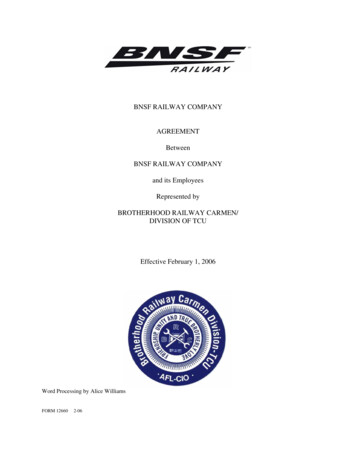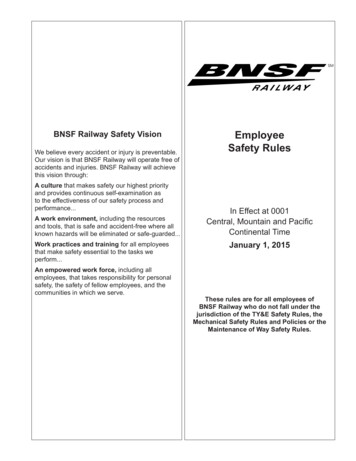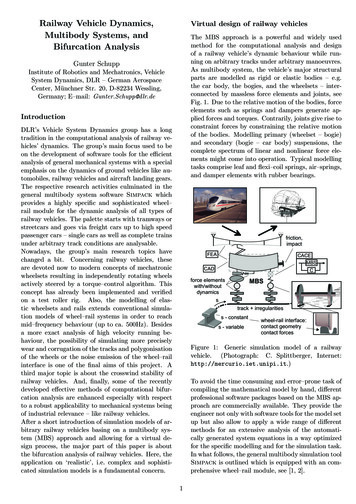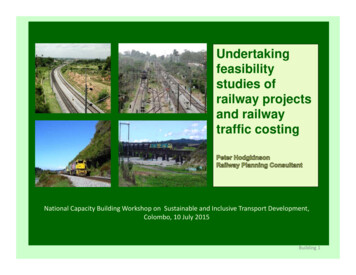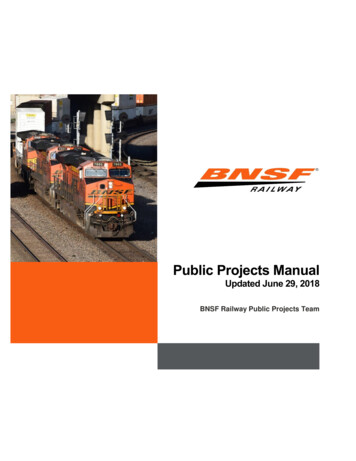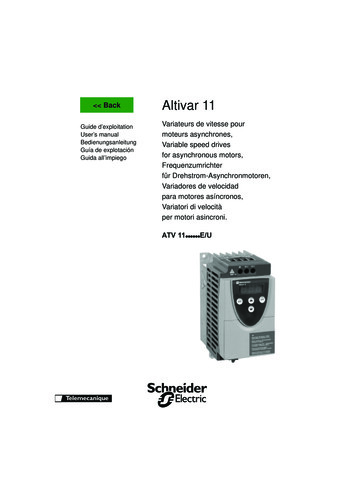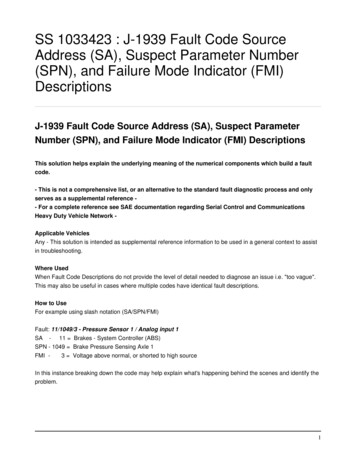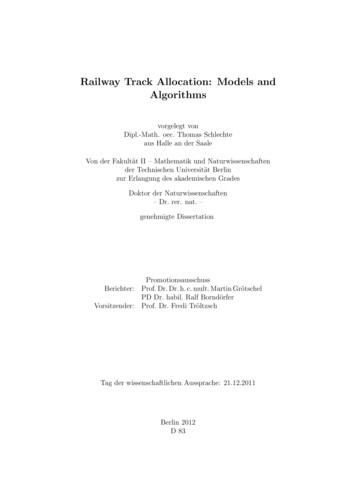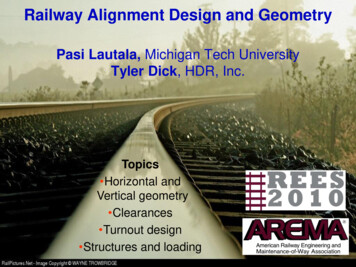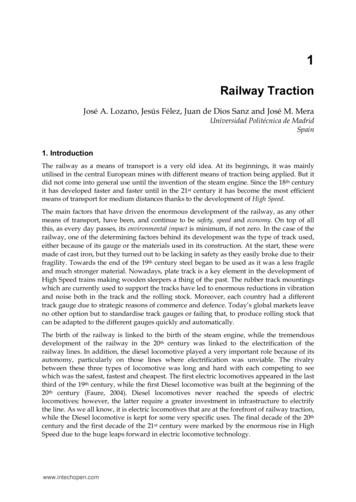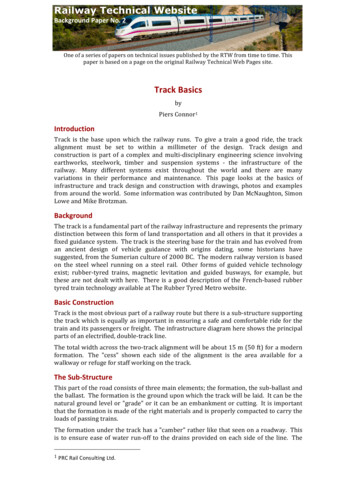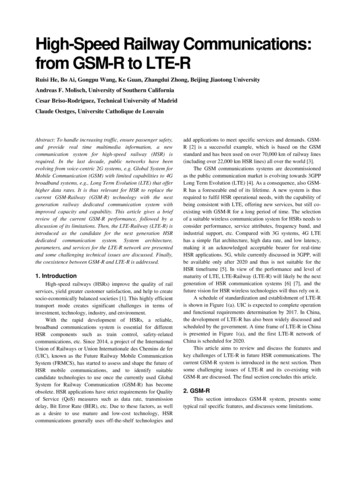
Transcription
High-Speed Railway Communications:from GSM-R to LTE-RRuisi He, Bo Ai, Gongpu Wang, Ke Guan, Zhangdui Zhong, Beijing Jiaotong UniversityAndreas F. Molisch, University of Southern CaliforniaCesar Briso-Rodriguez, Technical University of MadridClaude Oestges, Universite Catholique de LouvainAbstract: To handle increasing traffic, ensure passenger safety,and provide real time multimedia information, a newcommunication system for high-speed railway (HSR) isrequired. In the last decade, public networks have beenevolving from voice-centric 2G systems, e.g. Global System forMobile Communication (GSM) with limited capabilities to 4Gbroadband systems, e.g., Long Term Evolution (LTE) that offerhigher data rates. It is thus relevant for HSR to replace thecurrent GSM-Railway (GSM-R) technology with the nextgeneration railway dedicated communication system withimproved capacity and capability. This article gives a briefreview of the current GSM-R performance, followed by adiscussion of its limitations. Then, the LTE-Railway (LTE-R) isintroduced as the candidate for the next generation HSRdedicated communication system. System architecture,parameters, and services for the LTE-R network are presentedand some challenging technical issues are discussed. Finally,the coexistence between GSM-R and LTE-R is addressed.1. IntroductionHigh-speed railways (HSRs) improve the quality of railservices, yield greater customer satisfaction, and help to createsocio-economically balanced societies [1]. This highly efficienttransport mode creates significant challenges in terms ofinvestment, technology, industry, and environment.With the rapid development of HSRs, a reliable,broadband communications system is essential for differentHSR components such as train control, safety-relatedcommunications, etc. Since 2014, a project of the InternationalUnion of Railways or Union Internationale des Chemins de fer(UIC), known as the Future Railway Mobile CommunicationSystem (FRMCS), has started to assess and shape the future ofHSR mobile communications, and to identify suitablecandidate technologies to use once the currently used GlobalSystem for Railway Communication (GSM-R) has becomeobsolete. HSR applications have strict requirements for Qualityof Service (QoS) measures such as data rate, transmissiondelay, Bit Error Rate (BER), etc. Due to these factors, as wellas a desire to use mature and low-cost technology, HSRcommunications generally uses off-the-shelf technologies andadd applications to meet specific services and demands. GSMR [2] is a successful example, which is based on the GSMstandard and has been used on over 70,000 km of railway lines(including over 22,000 km HSR lines) all over the world [3].The GSM communications systems are decommissionedas the public communication market is evolving towards 3GPPLong Term Evolution (LTE) [4]. As a consequence, also GSMR has a foreseeable end of its lifetime. A new system is thusrequired to fulfil HSR operational needs, with the capability ofbeing consistent with LTE, offering new services, but still coexisting with GSM-R for a long period of time. The selectionof a suitable wireless communication system for HSRs needs toconsider performance, service attributes, frequency band, andindustrial support, etc. Compared with 3G systems, 4G LTEhas a simple flat architecture, high data rate, and low latency,making it an acknowledged acceptable bearer for real-timeHSR applications. 5G, while currently discussed in 3GPP, willbe available only after 2020 and thus is not suitable for theHSR timeframe [5]. In view of the performance and level ofmaturity of LTE, LTE-Railway (LTE-R) will likely be the nextgeneration of HSR communication systems [6] [7], and thefuture vision for HSR wireless technologies will thus rely on it.A schedule of standardization and establishment of LTE-Ris shown in Figure 1(a). UIC is expected to complete operationand functional requirements determination by 2017. In China,the development of LTE-R has also been widely discussed andscheduled by the government. A time frame of LTE-R in Chinais presented in Figure 1(a), and the first LTE-R network ofChina is scheduled for 2020.This article aims to review and discuss the features andkey challenges of LTE-R in future HSR communications. Thecurrent GSM-R system is introduced in the next section. Thensome challenging issues of LTE-R and its co-existing withGSM-R are discussed. The final section concludes this article.2. GSM-RThis section introduces GSM-R system, presents sometypical rail specific features, and discusses some limitations.
2008201220132014201520162017201820192020 20222025ParameterFrequencyGSM-RLTEUplink: 876800 MHz, 1.8880 MHz;GHz, 2.6 GHzDownlink: 921925 MHzLTE-R450 MHz, 800MHz, 1.4 GHz,1.8 GHzBandwidth0.2 MHz1.4-20 MHz1.4-20 MHzModulationGMSKQPSK/M-QPSK/16-QAM/OFDMQAMCell Range8 km1-5 km4-12 kmCell Configuration Single SectorMulti-SectorSingle SectorPeak Data Rate, 172/172 Kbps100/50 Mbps50/10 Mbps16.32 bps/Hz2.55 bps/HzDownlink/UplinkPeakSpectral 0.33 bps/HzEfficiencyData Transmission Requires voice Packetcall connection(a)switchingPacketswitching(UDP data)PacketNo (Serial data) YesRetransmission(IP Reduced (UDPpackets)packets)2x2, 4x42x2MIMONoMobilityMax. 500 km/h Max. 350 km/h Max. 500 km/hHandover Success 99.5% 99.5% oreaAll IP (native)Soft: No datalossNoYesYesTable 1 System parameters of GSM-R, LTE, and LTE-R2.2 Services(b)Figure 1 (a) Time frame of LTE-R in Europe and China. (b)Allocation of frequency bands.2.1 System DescriptionGSM-R is essentially the same system as the GlobalSystem for Mobile Communications (GSM), but with railwayspecific functionalities. It uses a specific frequency bandaround 800/900 MHz, as illustrated in Figure 1(b) [8]. Inaddition, the frequency bands 873-876 MHz (Uplink) and 918921 MHz (Downlink) are also used as extension bands forGSM-R on a national basis, under the name Extended GSM-R(E-GSM-R).GSM-R is typically implemented using dedicated basestations (BSs) close to the rail track. The distance between twoneighboring BSs is 7–15 km; whereas in China, it is 3-5 kmsince redundancy coverage is used to ensure higher availabilityand reliability. GSM-R has to fulfil tight availability andperformance requirements of the HSR radio services. Table 1summarizes some key parameters of GSM-R systems.GSM-R network serves as a data carrier for the EuropeanTrain Control System (ETCS), which is the signaling systemused for railway control. ETCS has 3 levels of operation and ituses the GSM-R radio network to send and receive informationfrom trains. On the first level, i.e., ETCS-1, the GSM-R is usedonly for voice communications. On the other two levels,ETCS-2 and ETCS-3, the GSM-R system is used mainly fordata transmissions. The GSM-R is very relevant to ETCS-2 andETCS-3, where the train travels at a speed up to 350 km/h andit is thus necessary to guarantee a continuous supervision oftrain position and speed. When the call is lost, the train has toautomatically reduce the speed to 300 km/h (ETCS-1) or lower.We briefly discuss in the following the most typical HSRspecific services offered by GSM-R [9]:1) Voice Group Call Service (VGCS): this conducts groupcalls between trains and BSs; or conducts group calls betweentrackside workers, station staff and similar groups.2) Voice Broadcast Service (VBS): the BS broadcastsmessages to certain groups of trains; or trains broadcastmessages to BSs and other trains in a defined area. Comparedto VGCS, only the initiator of the call can speak in VBS andthe others who join the call can only be listeners. VBS ismainly used to broadcast recorded messages or to makeannouncements in the operation of HSR.
3) Multi-Level Enhanced Precedence and Pre-Emption(eMLPP): this defines the user's priority and is used to achievehigh performance for emergency group calls.4) Shunting Mode: The purpose of shunting mode is toprovide an effective means of communication to a group ofpersonnel who are involved with a shunting operation. Thisapplication regulates and controls user access to shuntingcommunications. Shunting communication is a Link AssuranceSignal (LAS) that is used to give reassurance to the train driver.5) Functional Addressing: a train can be addressed by anumber identifying the function for which it is being used,rather than a more permanent subscriber number.6) Location Dependent Addressing: calls from a train tocertain functions can be addressed based on the location of thetrain, as the train moves through different areas of BSs.Due to above limitations, GSM-R must eventually evolvein order to eliminate revealed shortcomings [11]. LTE-R,which could be based on LTE standard, is a likely candidate toreplace GSM-R in the future for the following reasons: i) LTEhas many advantages over GSM in terms of capacity andcapabilities; ii) as a fully packet-switched based network, LTEis better suited for data communications; iii) LTE offers a moreefficient network architecture and thus has a reduced packetdelay, which is one of the crucial requirements for providingETCS messages; iv) LTE has a high throughput radio access asit consists of a number of improvements that increase spectralefficiency such as the advanced multiplexing and modulation;and v) LTE is also a well-established and off-the-shelf system,and provides standardized interworking mechanisms with GSM.3. LTE-R2.3 LimitationsAlthough the popularity of GSM-R is still growing,increasing interference from public networks is hampering theuse of GSM-R while the assigned radio frequencies limit itscapacity. Several limitations are summarized as follows.1) Interference: The interference between GSM-R andother public networks increases due to the fact that bothrailway and public operators want to have good coverage alongthe rail tracks. Instead of cooperating in network planning,railway and public operators “fight for” the coverage. Theinterference could result in severe impairment of voice and datacommunications as well as network loss over several hundredmeters of track. Theoretically speaking, such interference canbe avoided if public operators do not use frequency bandsadjacent to those of GSM-R for the areas close to rail tracks;however, this is not well implemented in practice. In the future,interference may increase owing to the growth of GSM-Rnetwork deployment and the potential growth of publicnetworks.2) Capacity: The 4 MHz bandwidth of GSM-R can support19 channels of 200 KHz width. This is sufficient for voicecommunication, as voice calls are limited in time and do notoccupy resources continuously. However, the current capacityturns out to be insufficient for the next generation railwaysystem, where each train needs to establish a continuous dataconnection with a Radio Block Center (RBC), and each RBCconnection needs to constantly occupy one time slot. The radiocapacity can be increased by using more spectrum resources.3) Capability: As a narrowband system, GSM-R cannotprovide advanced services and adapt to new requirements. Themaximum transmission rate of GSM-R per connection is 9.6kbit/s, which is sufficient only for applications with lowdemands; message delay is in the range of 400 ms, which is toohigh to support any real-time application and emergencycommunication [10]. The future new services of HSRs such asreal time monitoring require a wideband system to have largerdata rate and short delay.This section presents the system parameters and possibleservices of LTE-R. Some challenging issues of LTE-Rimplementation are further discussed.3.1 System DescriptionTo provide improved and more efficient transmission forHSR communications, it is vital to consider frequency andspectrum usage for LTE-R. HSRs are important strategicinfrastructure and in some countries this argument is beingleveraged to convince governments that large spectrum chunksneeds to be allocated specifically for it. Some industry bodiesincluding the European Railway Agency (ERA), ChinaRailway, and UIC are working to secure spectrum allocationfor HSR use. Currently, most LTE system works at the bandsabove 1 GHz, such as 1.8 GHz, 2.1 GHz, 2.3 GHz, and 2.6GHz, although 700-900 MHz bands are also used in somecountries. Large bandwidth is available in the upper bands,giving a higher data rate; whereas lower frequency bands offerlonger distance coverage. Figure 1(b) summarizes the possiblefrequency bands for LTE-R in China, Europe, and Korea. As ahigh frequency band has larger propagation loss and moresevere fading, the radius of a LTE-R cell would be less than 2km (due to the strict requirement of signal-to-noise ratio (SNR)and BER in HSR), leading to a requirement of substantialinvestment for higher BS density, and frequent handovers.Therefore, the low frequency bands such as 450-470 MHz, 800MHz, and 1.4 GHz have been widely considered. Especiallythe 450-470 MHz band is already well adopted by the railwayindustry, therefore, dedicated bandwidth for professional usecan still be allocated from the local regulators. Furthermore, thecarrier aggregation capability of LTE will permit the use ofdifferent bands to overcome problems of capacity. Figure 1(b)presents the detailed frequency allocation of 450-470 MHz inChina [12], and it is feasible to allocate enough bandwidth forLTE-R within this band. In Europe, the FRMCS of UIC wouldlike to build on the current GSM-R investment by re-using theexisting mast sites which could save as much as 80-90% of thecost of a network. Railways are also concerned about
continuing to make use of their GSM-R masts, therefore aspectrum allocation under 1 GHz is more cost effective inEurope. However, the selection of frequency band depends ongovernment policy and differs for different countries.information of the train is detected by RBC and onboard radioequipment. This improves the accuracy of train tracking andthe efficiency of train dispatchment. LTE-R also can be used toprovide information transmission for future automatic drivingsystems.Figure 2 LTE-R architecture for HSR communication. SGSN:serving GPRS support node.Standard LTE includes a core network of Evolved PacketCore (EPC) and a radio access network of Evolved UniversalTerrestrial Radio Access Network (E-UTRAN). The InternetProtocol (IP)-based EPC supports seamless handovers for bothvoice and data to cell towers, and each E-UTRAN cell willsupport high data and voice capacity by High Speed PacketAccess (HSPA). As a candidate for the next generationcommunication system of HSR, LTE-R inherits all theimportant features of LTE and provides extra radio accesssystem to exchange wireless signals with Onboard Board Units(OBUs) and to match HSR specific needs. The futurearchitecture of LTE-R is presented in Figure 2 according to [4]and it shows that the core network of LTE-R is backwardscompatible with GSM-R.Compared with the public LTE networks, LTE-R hasmany differences such as architecture, system parameters,network layout, services, QoS, etc. The preferred parameters ofLTE-R are summarized in Table 1, based on the future QoSrequirements of HSR communications. Note that LTE-R willbe configured for reliability more than capacity. The networkmust be able to operate at 500 km/h speed in the complexrailway environments. Therefore, Quadrature Phase ShiftKeying (QPSK) modulation is preferred, and the packetnumber of retransmission must be reduced as much as possible.3.2 ServicesHSR communications intend to use a well-established/offthe-shelf system, where some specific needs should be definedat the service level. As suggested by the E-Train project [6],LTE-R should provide a series of services to improve security,QoS, and efficiency. Compared with the traditional services ofGSM-R, some features of LTE-R are described as follows:1) Information transmission of control systems: To enablecompatibility with the ETCS-3 or the Chinese Train ControlSystem Level 4 (CTCS-4), LTE-R provides real timeinformation transmission of control information via wirelesscommunications, with a less than 50 ms delay. While thelocation information of the train is detected by a track circuit inETCS-2/CTCS-3, in ETCS-3/CTCS-4 and LTE-R, the locationFigure 3 LTE-R services.2) Real time monitoring: LTE-R provides videomonitoring of front rail track, cabin, and car connectorconditions; real time information monitoring of the rail trackconditions (e.g., temperature and flaw detection); videomonitoring of railway infrastructures (e.g., bridges and tunnels)to avoid natural disasters; and video monitoring of cross-tracksto detect freezing at low temperatures. The monitoringinformation will be shared with both the control center and thehigh-speed train in real time, with a less than 300 ms delay.Though some of the above surveillance can be conducted bywired communications, the wireless-based LTE-R system ismore cost-effective for deployments and maintenances.3) Train multimedia dispatching: It provides fulldispatching information (including text, data, voice, images,video, etc.) of drivers and yards to the dispatcher, and improvesdispatching efficiency. It supports rich functionalities such asvoice trunking, dynamic grouping, temporary group call, shortmessaging, and multimedia messaging, etc.4) Railway emergency communications: When naturaldisasters, accidents or other emergencies occur, it is required toestablish communications quickly between accident site andrescue center to provide voice, video, data, and imagetransmissions. Railway emergency communication systems usethe railway private network to ensure rapid deployment andfaster response (with a less than 100 ms delay) compared withGSM-R.5) Railway Internet-of-Things (IoT): LTE-R provides therailway IoT services such as real time query and tracking oftrains and goods. It helps to enhance transport efficiency andextend service ranges. Moreover, railway IoT could alsoimprove train safety. Most of today’s trains rely on trackside
3.3 Challenges1) HSR-specific scenarios: In the LTE standard of [14], achannel model for HSR is presented, which only includes twoscenarios: open space and tunnel, and [14] uses a non-fadingchannel model in both scenarios. However, as indicated by [15],the strict demands (high velocity, rail track flatness, etc.) ofHSRs lead to many HSR-specific environments, such asviaducts, cuttings, tunnels, etc. The propagation characteristicsin those scenarios are distinct from the traditional cellularcommunications and may significantly impact the systemperformances of GSM-R and LTE-R. In the past, somemeasurements were conducted to characterize the HSRchannels for GSM-R band, and a scenario-based path loss andshadow fading model has been proposed in [16] [17] for GSMR at 930 MHz. However, this work is still ongoing and manyscientific issues have not been solved at LTE-R band yet, e.g.,propagation loss, geometry distribution of MultipathComponents (MPCs) and 2D/3D angular estimation in thoseHSR-specific environments. It is necessary to develop a seriesof channel models for the link budget and network design ofLTE-R, and extensive channel measurements are needed.2) High mobility: High-speed trains usually run at a speedof 350 km/h, and LTE-R is designed to support 500 km/h. Thehigh velocity leads to a series of problems: i) High velocityresults in a non-stationary channel, because in a short timesegment the train travels over a large region, where the MPCschange significantly. Characterization of the non-stationarity isof special importance as it affects the BER in single-carrier andmulticarrier systems. ii) High velocity leads to a shift of thereceived frequency, called the Doppler shift. For example, ifthe frequency is 2.6 GHz, the maximum Doppler shift at 350km/h is 843 Hz, whereas it is only 24 Hz for a pedestrianmobile speed of 10 km/h. The large Doppler shift leads tophase shift of the signal and can impair the reception of anglemodulated signals. However, since the high-speed train mostlymoves along a scheduled line with a known speed, it is possibleto track and compensate for the Doppler shift by using the real-time recorded information of speed and position. iii) A largeDoppler spread is expected in HSR environments owing to thehigh velocity. For LTE-R (broadband system), Doppler spreadtypically leads to loss of signal-to-interference-plus-noise ratio(SINR) and can hamper carrier recovery and synchronization.Doppler spread is also of particular concern for OrthogonalFrequency Division Multiplexing (OFDM) systems, since itcan corrupt the orthogonality of the OFDM subcarriers. Severalapproaches such as frequency-domain equalization and theintercarrier interference self-cancellation scheme should beconsidered [18].3) Delay spread: Delay dispersion leads to a loss oforthogonality between the OFDM subcarriers, and a specialtype of guard interval, called the Cyclic Prefix (CP), should beemployed. The delay dispersion determines the required lengthof CP. LTE supports both short (4.76 us) and long (16.67 us)CP schemes. For the short CP scheme, the correspondingmaximum difference of path length between two MPCs is 1.4km. Since railway communications aim to provide linearcoverage, directional BS antennas with main lobes pointing toalong the rail track are widely used, so that transmit power isfocused on the narrow-strip-shaped regions. Intuitively, wewould anticipate that the short CP scheme is sufficient forLTE-R. This is especially true since high-speed trains mostlytravel in (semi-) rural/suburban environments, where there arefew scatterers. However, in some special environments withrich multiple reflections, such as cuttings, a large delay spreadis expected (note that a measurement-based validation isrequired) and long CP scheme should be used. Anotherexample for large delay spread occurs in the presence ofmountains along the rail track [19], especially before and afterthe train enters and leaves tunnels. More measurements arerequired to address the behaviors of delay spread in HSRenvironments, and the CP needs to be adjusted to theenvironment, just as with general LTE.1450 MHz0.9Percentage of Coverage Areaswitches located in the remote areas. With the IoT and remotemonitoring, it is possible to remake trackside infrastructurefrom switches to power lines. This could automate many of theroutine safety checks and reduce the costs of maintenances.Besides the above features, some other services of LTE-Rshould be included such as dynamic seat reservation, mobile Eticketing, and wireless interaction of passenger information, etc.Figure 3 summarizes the future possible services provided byLTE-R, which is based on the technical reports of UIC, ChinaRailway, and ERA. It is noteworthy that broadband wirelessaccess for passengers inside high-speed trains is not providedby LTE-R, because of its limited bandwidth. Some candidatesfor the broadband wireless access for train passengers havebeen discussed, such as WiFi, Worldwide Interoperability ications, and Radio-over-Fiber (RoF) technology [13].0.80.70.61.8 GHz0.50.40.30.20.10Circular CellLinear Cell51015202530Maximum Communication Distance [km]Figure 4 Coverage area predictions for HSR linear cell andcellular circular cell.4) Linear coverage: In HSRs, linear coverage withdirectional antenna along the rail track is used, where thedirectional BS antennas orientate their main lobe along the rail
track so that it is power-efficient. The linear coverage bringssome benefits, e.g., with the known location of a train, it ispossible to design distance/time-based beamforming algorithmswith good performance. However, it is noteworthy that the linkbudget and performance analysis of linear coverage is differentfrom the circular cell of cellular system, e.g., for thedetermination of percentage of coverage area. It is well knownthat due to the effect of shadow fading, some locations withinthe coverage area will have a received signal below a particularthreshold. Computing how the boundary coverage relates to theoverall percentage of coverage area is very useful for linkbudget and network planning. In Figure 4, we compare thedetermination of percentage of the coverage area for linear andcircular cells [20] using the Hata-based link budget model,where we can see that the linear coverage in HSRs generallyhas a higher percentage of coverage area. This should becarefully considered when designing LTE-R networks, to avoidan over-deployment of BSs.5) Sparse multipaths: Sparse multipath channels representa sparse distribution of resolvable paths in the angle-delayDoppler domain. As in some open areas of HSRs, e.g., viaduct,and rural areas, there are few scatterers. The linear coverage ofHSR also reduces the number of the scatterers that can be seenby Tx/Rx. It is possible to have a sparse multipath channel inthose environments. However, support for multiple-inputmultiple-output (MIMO) transmission will be an integral partof LTE-R. The performances of multi-antenna solutions suchas spatial diversity and spatial multiplexing depend on thescattering richness in the environments. If the HSR channelturns to be sparse in those open areas, the clear LOS and fewscatterers lead to strong correlation between signals of twoantennas, and reduce both diversity and spatial multiplexinggain. It has been indicated that in certain sparse environmentsreconfigurable antenna array [21] can improve system capacity.6) Impact of train car: A high-speed train usually is over200 m long, and made of metal. The static high-speed train actsas a scatterer with strong reflection and increases the delayspread, whereas the dynamic nature of the high-speed trainsignificantly increases the non-stationarity of channels. Thelarge metal roof of the train also increases reflections andscatterings near the Rx, and significantly affects the pattern ofthe Rx antenna on the roof. Moreover, propagation into theinterior of the high-speed train leads to large penetration lossand reduces SNR. The coverage inside the train car could beimproved with moving relays, similar to femtocell accesspoints.4. GSM-R and LTE-R CoexistenceAs GSM-R support by suppliers is committed until at least2028, and UIC has started the work on the succession of GSMR since 2009, it is expected that the co-existence between LTER and GSM-R will last for a long time. This can be elaboratedfrom several aspects:1) Business level: LTE-R needs to support the traditionalapplications of GSM-R, such as group call service, broadcastservice, functional addressing, etc. The Multimedia BroadcastMulticast Service (MBMS) of LTE, which is designed toprovide efficient delivery of broadcast and multicast services,would be a possible solution to provide group call andbroadcast services. The Session Initiation Protocol (SIP) is aprotocol for controlling multimedia communication sessionsand the SIP addressing would be a possible solution to providefunctional addressing in LTE-R.Figure 5 Future all-IP core network for HSR scenario. MME:mobility management entity, SAEGW: system architectureevolution gateway, GGSN: gateway GPRS support node. AAA:authentication, authorization, and accounting.2) Terminal level: the future HSR terminal should supportboth GSM-R and LTE-R. A multi-mode mobile terminal withlow complexity is a possible solution, whose disadvantagessuch as high power consumption and large size are notproblems for the HSR communication system.3) Access network level: direct coexistence of accessnetwork between GSM-R and LTE-R would be difficult sincethey both use different access technologies. It is possible forthe two networks to share sites at the first step and use softwaredefined radio (SDR) in the evolution from GSM-R to LTE-R.4) Core network level: as pointed out by the UIC E-Trainreport [6], IP technology is the basic technology used forconverging network capability. The goal of the HSR corenetwork is to achieve an all-IP core network, which isillustrated in Figure 5, where GSM-R, LTE-R, wireless localarea networks (WLAN), and Trans-European Trunked Radio(TETRA) are all connected to the core network. The all-IP corenetwork supports end-to-end IP connectivity, distributedcontrol and services, and gateways to legacy networks, wherewireless base stations can be connected to the all-IP corenetwork via IP protocol. The mobile switching center (MSC),home location register (HLR), and authentication center (AUC)of GSM-R will be replaced with the server and database ofLTE-R, and the protocol of signaling network will be replacedwith IP protocol. The whole network will evolve from verticaltree structure to distributed routing structure.
5. Conclusion[9] UIC GSM-R Operators Group, “GSM-R system requirementsThis article provides an overview of HSR dedicatedcommunication systems. The current narrowband GSM-R ispresented and its limitations are discussed. LTE-R, which is alikely candidate for the next generation HSR communicationsis introduced. LTE-R will be a special configuration of LTE. Ithas the ability to fulfill railway requirements and it will workas corporative network for railway operation and services. Thepossible system parameters and services of LTE-R aredescribed and some challenging issues are discussed.Coexistence between GSM-R and LTE-R is finally addressed.LTE-R offers highly competitive performance and provides agood foundation for further evolution. Despite this advantage,LTE-R has to be explicitly evaluated to further prove that it isable to fulfill the requirements of HSR, e.g., propagationcharacteristics and cell coverage at LTE-R band, the support ofhigh mobility, system capacity and capability, etc. Hence, moreinvestigations of LTE-R are needed.specification (SRS),” UIC EIRENE Technology Report, UIC Code 951,version 15.3.0, 2012, pp. 1-170.[10] P. Winter, “Compendium on ERTMS: European rail trafficmanagement system,” Eurail Press, 2009.[11] A. Sniady and J. Soler, “Capacity gain with an altern
Mobile Communication (GSM) with limited capabilities to 4G broadband systems, e.g., Long Term Evolution (LTE) that offer higher data rates. It is thus relevant for HSR to replace the current GSM-Railway (GSM-R) technology with the next generation railway dedicated communication system with improved capacity and capability. This article gives a .
